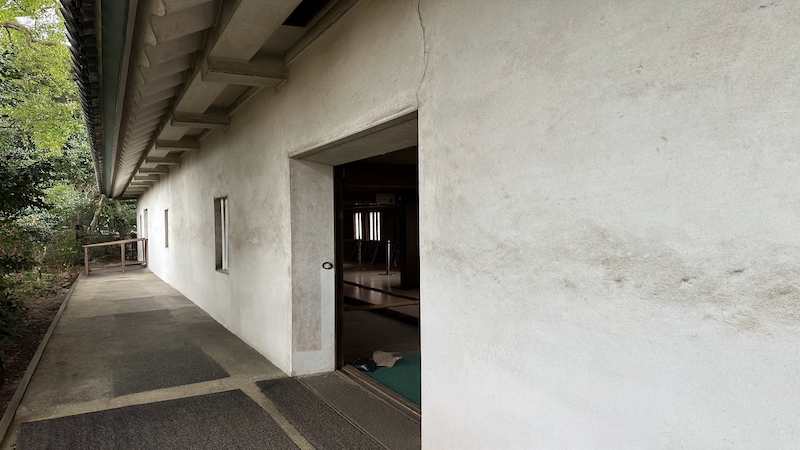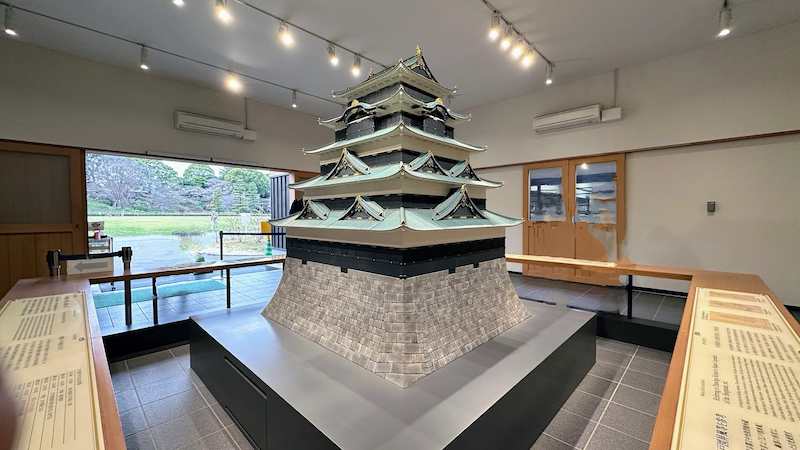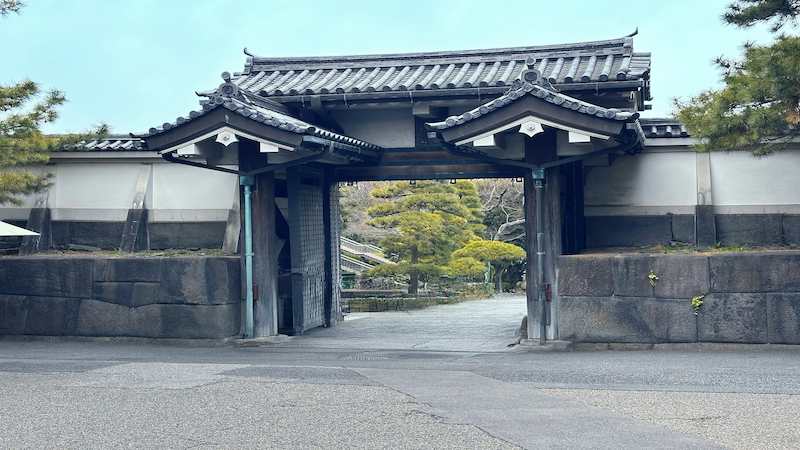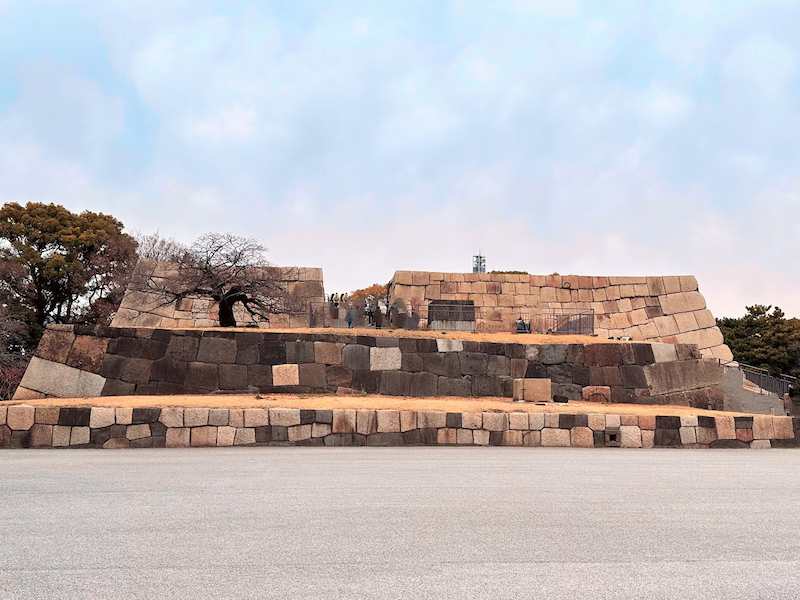As you pass through the Fujimi Yagura area and step into the Honmaru area, you find yourself in the very heart of Edo Castle. This was once the central hub of the Tokugawa Shogunate, and it is home to numerous historical sites that continue to tell the story of the grandeur of the Edo period. The remains of the Honmaru, the Tenshudai (castle keep foundation), and the Fujimi Tamon, the only surviving tamon (corridor-style storehouse) in Edo Castle, are among the highlights of this historically rich area. Standing on the same ground where shoguns once walked, you can imagine the vast scale and splendor of the past. In this article, we will explore the fascinating attractions of the Honmaru area in detail.
Honmaru Area
Fujimi Tamon
⭐ Recommended Rating
Historical :☆☆
Visual value:☆☆
Experiential:☆☆☆

Fujimi Tamon is a defensive structure located on the western side of Edo Castle’s Honmaru and is the only surviving tamon (a longhouse-style armory) in the castle. Built atop the castle’s stone walls, tamon structures served both defensive and decorative purposes while also functioning as storage for weapons and tools. Fujimi Tamon was originally destroyed in the Great Fire of Meireki in 1657 and was subsequently rebuilt in 1659. Later, it suffered damage from the Great Kanto Earthquake in 1923 but was restored in 1925. In 1968, it underwent dismantling and repair, resulting in its present-day appearance. It is said that shoguns once enjoyed views of Mount Fuji and the sea of Shinagawa from this structure.
| Item | Content |
|---|---|
| Year Built | 1659 (Manji 2) |
| Builder | Matsudaira Tadamasa (Lord of Fukui Domain) |
| Structure/Features | Long warehouse-style turret on stone walls used for defense and storage |
| Renovation/Restoration | Repaired after the 1923 Great Kanto Earthquake; dismantled and restored in 1968 |
| Current Status | Still existing |
| Destruction/Damage | Destroyed in the 1657 Great Fire of Meireki |
| Cultural Property Designation | Unknown |
| Remarks | – |
🗺 Address: 1-1 Chiyoda, Chiyoda-ku, Tokyo
🚶 Access
About 1 minute walk (about 100m) from the ruins of the Pine Corridor
⏳ Recommended Visiting Time
- Quick visit: Approximately 15 minutes
- In-depth exploration: Approximately 30 minutes
📍 Highlights
- Fujimi Tamon: The only remaining tamon in Edo Castle, once used to store weapons and tools.
- Stone Walls: The towering 19-meter-high stone walls beneath the tamon offer a breathtaking sight.
- Seasonal Beauty: In spring, the surrounding cherry blossoms create a stunning view.
📌 Trivia
- Unexpected Historical Background: Fujimi Tamon was rebuilt in 1659 after being destroyed in the Great Fire of Meireki in 1657.
- A Hidden Historical Spot: The interior of the tamon is rarely open to the public, making glimpses inside a rare opportunity.
- Connections to Famous Figures: It is said that shoguns once gazed at Mount Fuji and the sea of Shinagawa from this tamon.
Ishimuro (Stone Chamber)

⭐ Recommended Rating
Historical Significance: ☆☆
Visual Appeal: ☆☆
Experiential Value: ☆☆
🏛 Overview
The Ishimuro, or Stone Chamber, is a stone-built storehouse located along the Hasuike-bori (Lotus Moat) within the East Gardens of the Imperial Palace. This compact structure covers approximately 20 square meters and is meticulously constructed using interlocking andesite blocks known as Izu-ishi, quarried from Japan’s Izu Peninsula.
The chamber’s exact purpose remains uncertain, though it is widely believed to have served as a fireproof shelter for storing valuable furnishings and official documents from the Ōoku (the women’s quarters) during fires. While some theories suggest it may have been a secret escape route or a treasury (okinzō), its location near the Ōoku strongly supports the fire safety theory.
Traces of scorching can still be seen on the chamber’s surface—evidence of fires that once swept through Edo Castle. Today, Ishimuro stands as a silent witness to the shogunate’s architectural ingenuity and fire prevention efforts.
| Item | Content |
|---|---|
| Year Built | Unknown |
| Builder | Unknown |
| Structure/Features | Stone-walled storage built with Izu andesite blocks, fire-resistant structure |
| Renovation/Restoration | Unknown |
| Current Status | Still existing |
| Destruction/Damage | Scorch marks visible on outer walls |
| Cultural Property Designation | Unknown |
| Remarks | – |
🗺 Address
Inside the East Gardens of the Imperial Palace, Chiyoda-ku, Tokyo
🚶 Access
Approximately 1 minute walk from Fujimi Tamon (approximately 0.05km)
⏳ Suggested Visit Duration
- Quick visit: Around 5 minutes
- In-depth exploration: About 10 minutes
📍 Highlights
🔹 Structure of the Stone Chamber:
Crafted from Izu stone, the chamber showcases precision stone masonry and allows visitors to view its spacious interior.
🔹 Burn Marks:
Charred marks on the outer walls offer a glimpse into the devastating fires of the Edo period and the importance of fireproof storage.
🔹 Hasuike-bori Moat:
The nearby Lotus Moat provides a scenic backdrop, changing beautifully with the seasons.
📌 Trivia
Unexpected Historical Role:
Strategically located near the Ōoku of the Edo Castle Main Compound, the Ishimuro is believed to have functioned as an emergency storage vault during fires.
Little-Known Fact:
The Izu stone used in its construction was transported by boat from the Izu Peninsula and is renowned for its fire-resistant properties.
Connection to Historical Figures:
While no direct link to specific individuals has been documented, the chamber’s proximity to the Ōoku suggests it once stood near areas frequented by shoguns and prominent women of the Edo period.
Honmaru Ruins
⭐ Recommended Rating
Historical :☆☆☆
Visual value:☆
Experiential:☆

The Honmaru ruins of Edo Castle are now a vast grassy area within the East Gardens of the Imperial Palace. During the Edo period, this was where the shogun’s residence and the administrative center of the shogunate, the Honmaru Palace, stood. The palace was divided into three sections: the Outer Palace, the Middle Quarters, and the Inner Palace. The Outer Palace served as an office for officials and as a venue for official ceremonies, with the “Great Hall” being the most prestigious space where feudal lords gathered for New Year’s celebrations. The Honmaru Palace was known as “the supreme study hall of the nation” due to its grandeur and significance. However, it was repeatedly destroyed by fires and earthquakes, with the final destruction occurring in 1863, after which it was never rebuilt.
Take a 360° Look Around
| Item | Content |
|---|---|
| Year Built | Unknown |
| Builder | Unknown |
| Structure/Features | Large open lawn area where Honmaru Palace once stood |
| Renovation/Restoration | Not rebuilt after the 1863 fire |
| Current Status | Site remains; structures no longer exist |
| Destruction/Damage | Destroyed by fire in 1863 (Bunkyū 3) |
| Cultural Property Designation | Unknown |
| Remarks | – |
🗺 Address: 1-1 Chiyoda, Chiyoda-ku, Tokyo
🚶 Access
Approximately 2 minutes walk from the stone chamber (approximately 0.2km)
⏳ Recommended Visiting Time
- Quick visit: Approximately 10 minutes
- In-depth exploration: Approximately 20 minutes
📍 Highlights
- Honmaru Ruins Lawn Area: A spacious lawn marking the site of the former Honmaru Palace, offering different scenic views throughout the seasons.
📌 Trivia
- Unexpected Historical Background: The Honmaru Palace was repeatedly destroyed by fires, including the Great Fire of Meireki in 1657. It was last destroyed in 1863 and was never rebuilt.
- A Hidden Historical Spot: Beneath the Honmaru ruins, remnants of old stone walls and building foundations remain buried, attracting archaeological interest.
- Connections to Famous Figures: Edo Castle was the residence of the Tokugawa shogunate, witnessing many significant historical events. During the era of the third shogun, Tokugawa Iemitsu, the Tenshudai (castle keep foundation) was completed, marking the peak of Edo Castle’s splendor.
Edo Castle Tenshu Reconstruction Model
⭐ Recommended Rating
Historical :☆
Visual value:☆☆☆
Experiential:☆☆

The tenshu (main keep) of Edo Castle was built three times during the Keichō period (1607), Genna period (1623), and Kan’ei period (1638). However, it was destroyed in the Great Meireki Fire of 1657 and was never rebuilt. Currently, a 1/30 scale replica of the Kan’ei-period tenshu is on permanent display in the annex of the Honmaru Rest House in the East Gardens of the Imperial Palace.
| Item | Content |
|---|---|
| Year Built | 2020 (Reiwa 2) |
| Builder | Unknown |
| Structure/Features | 1/30 scale model of the Kan’ei-era Edo Castle Tenshu |
| Renovation/Restoration | None |
| Current Status | Still existing |
| Destruction/Damage | None |
| Cultural Property Designation | Unknown |
| Remarks | – |
🗺 Address: 1-1 Chiyoda, Chiyoda-ku, Tokyo
🚶 Access
About 1 minute walk from Honmaru ruins (about 0.01km)
⏳ Recommended Visit Duration
Quick visit: About 10 minutes
For a more in-depth experience: About 20 minutes
📍 Highlights
- Tenshu Reconstruction Model: A meticulously crafted replica of the Kan’ei-period tenshu, offering a glimpse into Edo-period architectural techniques and the grandeur of the castle keep.
- Honmaru Rest House: The exhibition space also features a rest area where visitors can relax and browse historical materials.
📌 Trivia
- Unexpected Historical Fact: Edo Castle’s tenshu was never rebuilt after the Great Meireki Fire, meaning no tenshu currently exists.
- Local Secret: The reconstruction model was opened to the public on September 29, 2020.
- Famous Connection: Tokugawa Iemitsu constructed the Kan’ei-period tenshu, symbolizing the authority of the Tokugawa shogunate.
Site of the Daidokoro-mae Three-Story Turret
⭐ Recommended Rating
Historical :☆☆
Visual value:☆☆☆
Experiential:☆☆

The Daidokoro-mae Three-Story Turret was once located on the eastern side of Edo Castle’s Honmaru (main enclosure). While the turret itself no longer exists, its stone foundation remains, allowing visitors to appreciate the former structure’s defensive role. Today, the site is developed as an observation platform, offering panoramic views of the Ninomaru Garden and Shiratori Moat. Visitors often describe it as a “rare place in the city where history and nature coexist.”
Take a 360° Look Around
| Item | Content |
|---|---|
| Year Built | Unknown |
| Builder | Unknown |
| Structure/Features | Remains of a three-story turret; stone foundation remains |
| Renovation/Restoration | None |
| Current Status | Stone base remains |
| Destruction/Damage | Burned in the 1863 Great Fire of Bunkyu |
| Cultural Property Designation | Unknown |
| Remarks | – |
🗺 Address: 1-1 Chiyoda, Chiyoda-ku, Tokyo
🚶 Access
Approximately 2 minutes walk (approximately 0.1km) from the Edo Castle tower replica
⏳ Recommended Visit Duration
Quick visit: About 10 minutes
For a more in-depth experience: About 20 minutes
📍 Highlights
- Observation Platform on the Stone Foundation: Offers sweeping views of Ninomaru Garden and Shiratori Moat, providing a beautiful seasonal landscape.
- Seasonal Beauty: In spring, cherry blossoms bloom around the site, creating a striking contrast with the stone walls.
📌 Trivia
- Unexpected Historical Fact: The Daidokoro-mae Three-Story Turret played a crucial role in Edo Castle’s defenses but was never rebuilt after the Great Meireki Fire of 1657.
- Hidden Historical Spot: The observation platform provides a unique view where modern cityscapes blend with historical gardens.
- Famous Connection: Tokugawa Ieyasu and successive shoguns are said to have passed by this site on their way to the Honmaru.
Site of Edo Castle Tenshudai (Main Keep Foundation)
⭐ Recommended Rating
Historical :☆☆☆
Visual value:☆☆☆
Experiential:☆☆☆

The Edo Castle tenshudai marks the site where the castle’s main keep once stood. Although the tenshu was rebuilt three times throughout the Edo period, it was ultimately destroyed in the Great Meireki Fire of 1657 and never reconstructed. Today, only the stone foundation remains, situated within the East Gardens of the Imperial Palace, serving as a testament to the castle’s grandeur.
Take a 360° Look Around
| Item | Content |
|---|---|
| Year Built | 1606 (Keichō 11) |
| Builder | Tokugawa Ieyasu |
| Structure/Features | Stone base approx. 11m tall and 41m wide |
| Renovation/Restoration | None |
| Current Status | Stone base still remains |
| Destruction/Damage | Keep destroyed in the 1657 Great Fire of Meireki |
| Cultural Property Designation | Unknown |
| Remarks | – |
🗺 Address: 1-1 Chiyoda, Chiyoda-ku, Tokyo
🚶 Access
About 5 minutes walk from the Daidokoro-mae Sanju Yagura ruins (about 0.4 km)
⏳ Recommended Visit Duration
Quick visit: About 10 minutes
For a more in-depth experience: About 20 minutes
📍 Highlights
- Tenshudai Stone Foundation: Standing 11 meters tall and 41 meters wide, this massive structure showcases Edo-period stonework techniques.
- Panoramic Views from the Tenshudai: Visitors can enjoy a breathtaking view of the East Gardens of the Imperial Palace and Tokyo’s modern skyline, where history and contemporary life converge.
- Seasonal Beauty: In spring, cherry blossoms create a stunning contrast with the tenshudai’s stone walls.
📌 Trivia
- Unexpected Historical Fact: Plans for rebuilding the tenshu were abandoned due to financial difficulties and political considerations.
- Hidden Historical Spot: The stone foundation still bears the engraved marks of feudal lords who transported the stones, which can be discovered upon close inspection.
- Famous Connection: During discussions about the tenshu’s reconstruction, Hoshina Masayuki, a key Tokugawa advisor, argued that a main keep was not essential, ultimately leading to the project’s cancellation.
Kita-hanebashi Gate
⭐ Recommended Rating
Historical :☆☆
Visual value:☆☆☆
Experiential:☆☆

The Kita-hanebashi Gate is located at the northern edge of Edo Castle’s Honmaru, marking the boundary with the Kitanomaru area. The gate’s name, “hanebashi” (literally “drawbridge”), originates from the fact that the bridge in front of the gate could be raised in times of emergency. This gate provided direct access to the castle keep and served as a key defensive point for the northern side of the castle.
| Item | Content |
|---|---|
| Year Built | Unknown (believed to be early Edo period) |
| Builder | Tokugawa Shogunate |
| Structure/Features | Masugata-style layout with a Kōraimon gate; formerly featured a drawbridge-style structure |
| Renovation/Restoration | Renovated in 1968 |
| Current Status | Kōraimon gate and bridge remain |
| Destruction/Damage | Unknown |
| Cultural Property Designation | Not designated |
| Remarks | – |
🗺 Address: 1-1 Chiyoda, Chiyoda-ku, Tokyo
🚶 Access
About 3 minutes walk (about 200 meters) from the remains of the castle tower
⏳ Recommended Visit Duration
Quick visit: About 5 minutes
For a more in-depth experience: About 15 minutes
📍 Highlights
- Kabukimon Gate and Bridge Remains: The remaining structures offer a glimpse into Edo Castle’s architectural ingenuity.
- Scenic Views of Hirakawa Moat and Inui Moat: The beautiful moats surrounding the gate create a tranquil setting.
- Edo Castle Tenshudai Site: Upon passing through the gate, visitors encounter the remnants of Edo Castle’s former main keep, evoking the grandeur of the past.
📌 Trivia
- Unexpected Historical Fact: During the era of Ōta Dōkan, this area was considered the castle’s main entrance.
- Hidden Historical Spot: Metal fittings used to suspend pulleys for the drawbridge mechanism can still be seen on the gate’s pillars.




comment